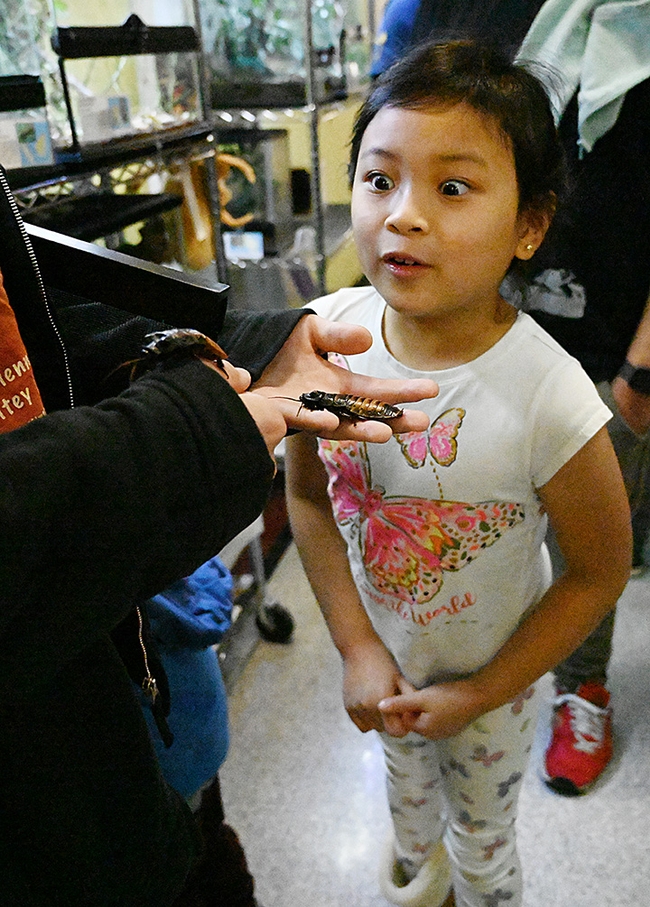
Scientists also encouraged the visitors to touch or handle a few of the live specimens, including millipedes, Madagascar hissing cockroaches and walking sticks.
Doctoral candidates Emma Jochim and Xavier Zahnle of the Jason Bond arachnology lab opened the event with a 30-minute mythbusting session moderated by doctoral student Iris Quayle of the Bond lab. (See the UC Davis Entomology and Nematology website for which myths they busted, and watch their YouTube-posted video on brown recluse spiders.)
The trio studies with major professor Jason Bond, the Evert and Marion Schlinger Endowed Chair in Insect Systematics, UC Davis Department of Entomology and Nematology, and associate dean, College of Agricultural and Environmental Sciences.
Following the mythbusting, Jochim, Zahnle and Quayle and researcher and project scientist Jim Starrett of the Bond lab (he holds a doctorate in genetics, genomics and bioinformatics from UC Riverside), teamed with Davis students to showcase critters. Elijah Shih, a third-year UC Davis transfer student who plans to pursue a career in veterinary medicine, displayed his isopods. Bohart Museum research associate Brittany Kohler, the "zookeeper" of the Bohart's live petting zoo, provided tarantulas, black widows, a brown widow, a centipede, Madagascar hissing cockroaches, stick insects and ironclad beetles, among others.
The tarantulas sport such names as "Princess Herbert," "Peaches" and "Coco McFluffin." Starrett wowed the crowd at two "feeding times" for Princess Herbert. The menu? Crickets, which she instantly devoured. Princess Herbert, the Bohart Museum's oldest tenant in its petting zoo, is a Brazilian salmon-pink bird-eating tarantula (Lasiodora parahybana).
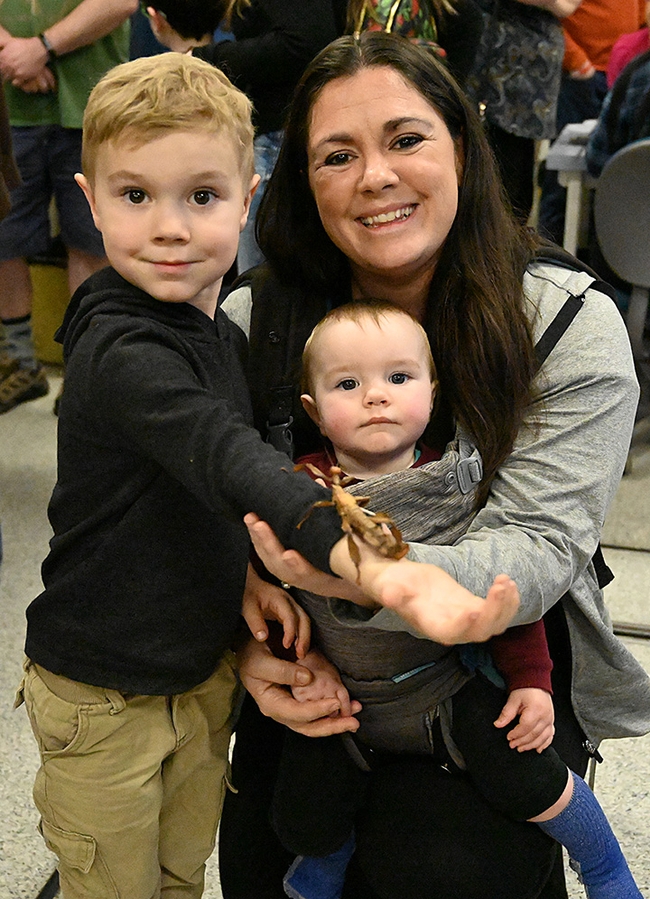
Kim Crawford of Cameron Park and her daughter, Emma, 10, loved the millipedes. Valentina Leijja, 8, of Mexico City, attending with her parents, Martha Leija and Mario Preciado, asked scores of questions of doctoral student Emma Jochim and then visited the Lepitoptera section to see the butterflies and moths, being shown by Bohart associate Greg Kareofelas and Kohler.
Meanwhile, the arts-and-crafts table came to life with newly sculptured arachnids, carefully modeled of clay. (More on pending Bug Squad posts.)
Tabatha Yang, the Bohart Museum's education and outreach coordinator, estimated that more than 350 attended. "The open house featured arachnids, myriapods, isopods and even some tardigrades (also known as water bears)," she said.
A tardigrade scupture, the work of Solomon Bassoff, fronts the entrance to the Academic Surge Building. The Bohart Museum houses one of the world's largest collections of tardigrades. The current collection includes some 25,000 slide-mounted specimens. In a recent newsletter, Bohart Museum director Lynn Kimsey described the water bear as “one of the most peculiar and indestructible groups of animals known. The microscopic and nearly indestructible tardigrade can survive being heated to 304 degrees Fahrenheit or being chilled for days at -328 F. And, even if it's frozen for 30 years, it can still reproduce." See video on EurekAlert.
The Bohart Museum, part of the UC Davis Department of Entomology and Nematology, houses a global collection of eight million insect specimens, plus the live petting zoo, and a gift shop stocked with insect-themed books, posters, jewelry, t-shirts, hoodies and more. Founded in 1946 and named for UC Davis professor Richard Bohart, it is dedicated to "understanding, documenting and communicating terrestrial arthropod diversity." It is open to the public Mondays through Thursdays, from 8 a.m. to noon, and 1 to 5 p.m. More information is available on the Bohart website at https://bohart.ucdavis.edu or by emailing bmuseum@ucdavis.edu.
The Bohart Museum is now preparing for the annual campuswide UC Davis Picnic Day on Saturday, April 15. This year is the 109th annual.
Attached Images:
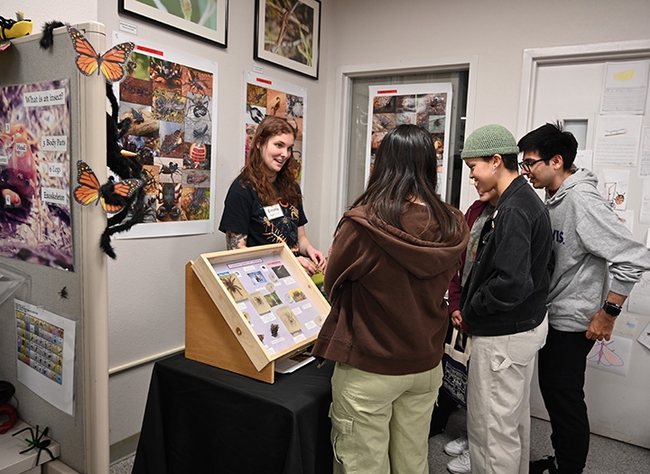
UC Davis doctoral student Emma Jochim answers questions at her station. (Photo by Kathy Keatley Garvey)
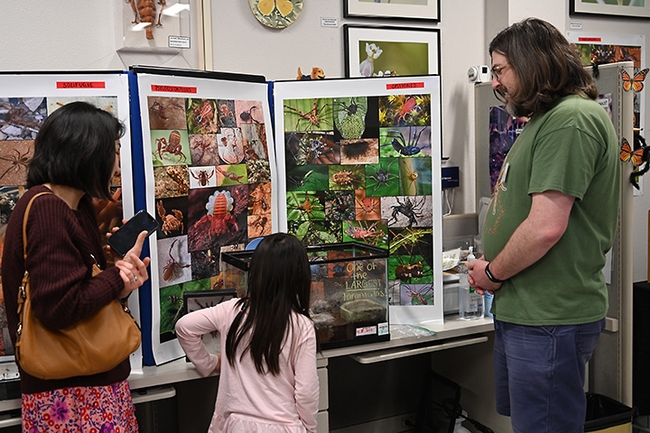
Researcher James Starrett, a project scientist in the Jason Bond lab who holds a doctorate in genetics, genomics and bioinformatics from UC Riverside, fields questions about Princess Herbert, a 20-year-old tarantula that's a tenant in the Bohart Museum live petting zoo. (Photo by Kathy Keatley Garvey)
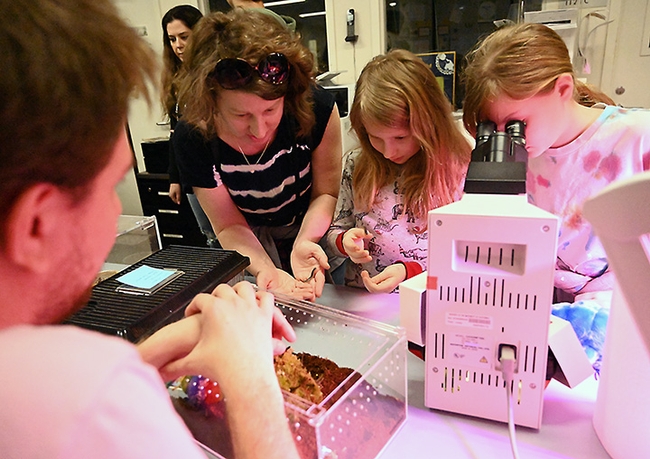
Kim Crawford of Cameron Park and her daughter, Emma, 10, hold millipedes. At left (foreground) is doctoral candidate Xavier Zahnle. (Photo by Kathy Keatley Garvey)
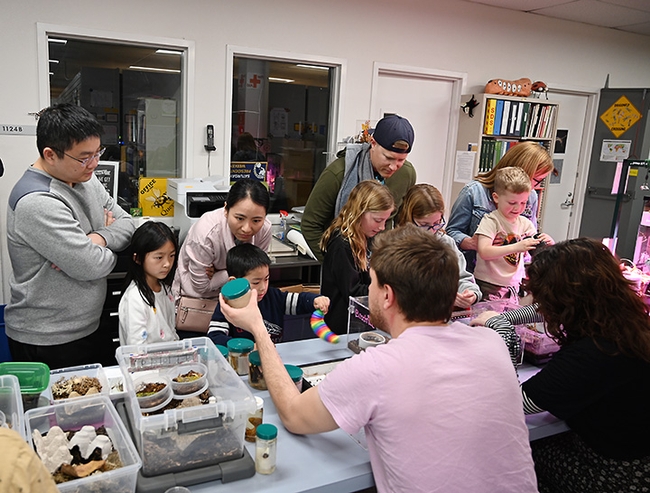
Doctoral candidate Xavier Zahnle greets visitors at the Bohart Museum open house. More than 350 attended. (Photo by Kathy Keatley Garvey)
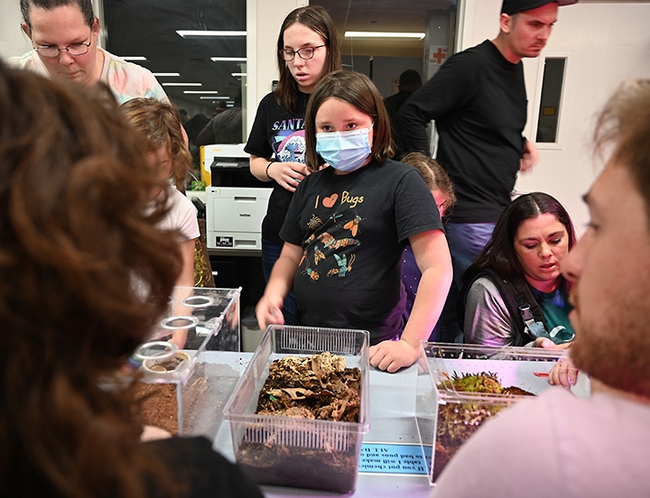
Insect enthusiast Rose Hager, 9, of Davis, wore her "I Love Bugs" t-shirt. (Photo by Kathy Keatley Garvey)